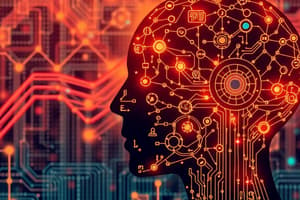Podcast
Questions and Answers
What is the primary function of language models in Natural Language Processing?
What is the primary function of language models in Natural Language Processing?
- To analyze and process existing data
- To summarize text
- To translate languages
- To predict the next word in a sequence and generate text (correct)
What is the difference between conditional and unconditional text generation?
What is the difference between conditional and unconditional text generation?
- Conditional text generation is used for language translation, while unconditional text generation is used for text summarization
- Conditional text generation is used for chatbots, while unconditional text generation is used for content generation
- Conditional text generation generates text based on a specific prompt, while unconditional text generation generates text without a prompt (correct)
- Conditional text generation uses sequence-to-sequence models, while unconditional text generation uses generative adversarial networks
What is the primary application of generative adversarial networks (GANs) in image generation?
What is the primary application of generative adversarial networks (GANs) in image generation?
- Image recognition
- Image compression
- Image synthesis (correct)
- Data augmentation
What is the primary application of sequence-to-sequence models in video generation?
What is the primary application of sequence-to-sequence models in video generation?
What is the primary technique used in generating original images from scratch?
What is the primary technique used in generating original images from scratch?
What is the primary application of text generation in Natural Language Processing?
What is the primary application of text generation in Natural Language Processing?
What is the primary difference between variational autoencoders (VAEs) and generative adversarial networks (GANs)?
What is the primary difference between variational autoencoders (VAEs) and generative adversarial networks (GANs)?
What is the primary application of video generation in the field of special effects?
What is the primary application of video generation in the field of special effects?
What is the primary technique used in generating original text from scratch?
What is the primary technique used in generating original text from scratch?
What is the primary application of image generation in the field of data augmentation?
What is the primary application of image generation in the field of data augmentation?
Flashcards are hidden until you start studying
Study Notes
Generative AI
Generative AI refers to a type of artificial intelligence that can generate new, original content, such as text, images, or videos, rather than simply processing or analyzing existing data.
Natural Language Processing (NLP)
- Text Generation: ability to generate coherent and natural-sounding text based on a given prompt or context
- Language Models: AI models trained on large datasets of text to predict the next word in a sequence, allowing them to generate text
- Applications: chatbots, language translation, text summarization, and content generation
Generate Text
- Types of Text Generation:
- Conditional Text Generation: generating text based on a specific prompt or condition
- Unconditional Text Generation: generating text without a specific prompt or condition
- Techniques:
- Sequence-to-Sequence Models: using encoder-decoder architectures to generate text
- Generative Adversarial Networks (GANs): using generator and discriminator networks to generate text
- Applications: content generation, chatbots, and language translation
Pictures
- Image Generation: ability to generate original images from scratch or based on a prompt
- Techniques:
- Generative Adversarial Networks (GANs): using generator and discriminator networks to generate images
- Variational Autoencoders (VAEs): using encoder-decoder architectures to generate images
- Applications: image synthesis, data augmentation, and art generation
Videos
- Video Generation: ability to generate original videos from scratch or based on a prompt
- Techniques:
- Video-to-Video Translation: using sequence-to-sequence models to generate videos
- Video Generation using 3D Models: using 3D models to generate videos
- Applications: video synthesis, video editing, and special effects in movies and video games
Generative AI
- Generative AI generates new, original content, such as text, images, or videos, rather than processing or analyzing existing data.
Natural Language Processing (NLP)
- Text Generation involves generating coherent and natural-sounding text based on a given prompt or context.
- Language Models are AI models trained on large datasets of text to predict the next word in a sequence, allowing them to generate text.
- Applications of NLP include chatbots, language translation, text summarization, and content generation.
Generate Text
- Types of Text Generation include Conditional Text Generation (generating text based on a specific prompt or condition) and Unconditional Text Generation (generating text without a specific prompt or condition).
- Techniques for generating text include Sequence-to-Sequence Models (using encoder-decoder architectures) and Generative Adversarial Networks (GANs) (using generator and discriminator networks).
- Applications of text generation include content generation, chatbots, and language translation.
Pictures
- Image Generation involves generating original images from scratch or based on a prompt.
- Techniques for generating images include Generative Adversarial Networks (GANs) (using generator and discriminator networks) and Variational Autoencoders (VAEs) (using encoder-decoder architectures).
- Applications of image generation include image synthesis, data augmentation, and art generation.
Videos
- Video Generation involves generating original videos from scratch or based on a prompt.
- Techniques for generating videos include Video-to-Video Translation (using sequence-to-sequence models) and Video Generation using 3D Models (using 3D models).
- Applications of video generation include video synthesis, video editing, and special effects in movies and video games.
Studying That Suits You
Use AI to generate personalized quizzes and flashcards to suit your learning preferences.




